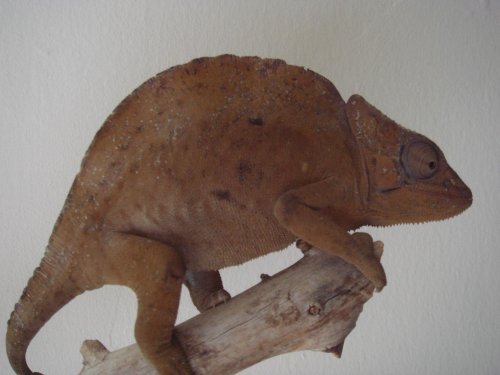Navigation
Install the app
How to install the app on iOS
Follow along with the video below to see how to install our site as a web app on your home screen.
Note: This feature may not be available in some browsers.
More options
You are using an out of date browser. It may not display this or other websites correctly.
You should upgrade or use an alternative browser.
You should upgrade or use an alternative browser.
Female Chamaeleo Trioceros deremensis Coloration
- Thread starter snk
- Start date
Lizardlover
New Member
not sure but now its just triocerous deremensis not chameleo triocerous
Eric Adrignola
Avid Member
They do, but I think this is different. I've seen some females show a red or brownish base color, as opposed to the normal, standard green. At night, is she the same color? If so, that's what you got - one of the unusual red female deremensis.
merumontanus
Avid Member
not sure but now its just triocerous deremensis not chameleo triocerous
It's not "official" yet, but probably will be eventually, though it's actually Trioceros, not "ous", and it's also capitalized as it is a (sub)genus.
Fabián
Lizardlover
New Member
i know, i wasnt being formal, i was just simply stating it,
merumontanus
Avid Member
Does gravid female Deremensis display different color such as light or dark brown? Have 2 females but both showing different colors.
The gravid females I have seen did not show a particular gravid coloration, but were much more agressive toward conspecifics. Red deremensis are rare in captivity and only remember seeing one other-- it was Leah Kroo's if my memory serves me well.
Fabián
merumontanus
Avid Member
i know, i wasnt being formal, i was just simply stating it,
It was stated incorrectly
ciafardo 4
New Member
it was stated incorrectly
haha nice correction
SliK JiM
New Member
I thought the change was official now? http://www.mapress.com/zootaxa/2009/f/z02079p068f.pdf
No, she stay in brownish color. I did had a female before was standard green color, however, after she mated, she turned to brown color and stay brown the whole time.
They do, but I think this is different. I've seen some females show a red or brownish base color, as opposed to the normal, standard green. At night, is she the same color? If so, that's what you got - one of the unusual red female deremensis.
merumontanus
Avid Member
I thought the change was official now? http://www.mapress.com/zootaxa/2009/f/z02079p068f.pdf
Hi James,
The key here is understanding the different between a scientific "proposal" and a peer-reviewed, internationally-accepted "theory". The paper you have kindly provided is, as its abstract shows, a proposal to elevate the current (as the paper itself maintains) status of Chamaeleo and Trioceros from subgenus to full genus. This does not mean that the paper is without merit or that it holds no significance. On the contrary, it is most likely to be accepted internationally, but for that to happen, it needs to be reviewed by other members of the scientific community. This includes the International Commission on Zoological Nomenclature, from which the International Code of Zoological Nomenclature (ICZN) is derived. Again, this does not mean that proposals not accepted by the ICZN are invalid, per se, as they may be awaiting further review, but the purpose of The Code is to maintain consistency internationally, otherwise anyone could manufacture their own taxon and call it a day.
Trioceros will attain full status sooner or later, but don't expect to see these changes in the immediate future at your nearest CITES or USFWS.
Cheers,
Fabián
Similar threads
- Replies
- 10
- Views
- 528
- Replies
- 26
- Views
- 2K



